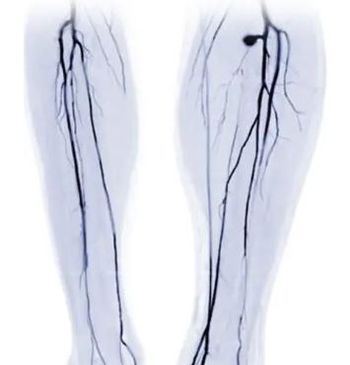
New Guidelines Issued for Venous Thromboembolism
KANSAS CITY -- New clinical-practice guidelines for the diagnosis and management of venous thromboembolism in primary care were released jointly by the American Academy of Family Physicians here and the American College of Physicians.
KANSAS CITY, Jan 29 -- New clinical-practice guidelines for the diagnosis and management of venous thromboembolism in primary care were released jointly by the American Academy of Family Physicians here and the American College of Physicians.
Key elements of the diagnostic guidelines include the use of clinical-prediction rules to establish the probability of deep venous thrombosis or pulmonary embolism prior to further testing.
The management guidelines support the use of low-molecular-weight heparin for patients with lower-extremity deep vein thrombosis in an outpatient setting, provided appropriate support services are in place.
The guidelines, as well as a companion diagnostic-evidence review, were published online and in the January-February issue of the Annals of Family Medicine. They will also be published in the Feb. 6, 2007, issue of the Annals of Internal Medicine.
The diagnostic guidelines are based on a systematic review of the evidence as detailed in a comprehensive evidence report published in 2003 and updated by members of the Johns Hopkins Evidence-Based Practice center, which prepared the original report.
The final diagnostic guidelines were based on a Quality Evidence-Based Practice Centers (EPC) program, and are intended to help practicing physicians deal with the diagnosis of lower-extremity deep-vein thrombosis and pulmonary embolism.
The importance of early diagnosis to prevent mortality and morbidity associated with venous thromboembolism cannot be overstressed, said Amir Qaseem, M.D., Ph.D., of the American College of Physicians, lead author of the diagnostic guidelines.
The main diagnostic recommendations are:
Recommendation 1. Validated clinical prediction rules should be used to estimate pretest probability of venous thromboembolism (VTE), both deep venous thrombosis and pulmonary embolism, and for the basis of interpretation of subsequent tests.
The Wells prediction rules for DVT and for pulmonary embolism have been validated and are frequently used to estimate the probability of venous thromboembolism before performing more definitive testing on patients.
The Wells prediction rule performs better in younger patients without comorbidities or a history of venous thromboembolism than it does in other patients. Physicians should use their clinical judgment in cases where a patient is older or presents with co-morbidities.
Recommendation 2. In appropriately selected patients with low pretest probability of DVT or pulmonary embolism, obtaining a high-sensitivity D-dimer is a reasonable option, and if negative, indicates a low likelihood of venous thromboembolism.
In selected patients with a low pretest probability of venous thromboembolism, a negative high-sensitivity D-dimer assay for has sufficiently high negative predictive value to reduce the need for further imaging studies.
Currently, enzyme-linked immunosorbent assay (ELISA), quantitative rapid ELISA, and advanced turbidimetric D-dimer determinations are highly sensitive assays and their use is practical in diagnosis of venous thromboembolism. In older patients, those with associated comorbidity, and long duration of symptoms, a D-dimer alone may not be sufficient to rule out VTE.
Recommendation 3. Ultrasound is recommended for symptomatic patients with intermediate to high pretest probability of DVT in the lower extremities.
Ultrasound is less sensitive in patients with a DVT limited to the calf; therefore, a negative ultrasound does not rule out DVT in these patients. Contrast venography is still considered the definitive test to rule out DVT.
Recommendation 4. Patients with intermediate or high pretest probability of pulmonary embolism require diagnostic imaging studies.
Possible tests include ventilation-perfusion scan, multidetector helical computed axial tomography, and pulmonary angiography. Recent reviews indicate that CT alone may not be sufficient. It is likely that the accuracy of CTs will improve with time as the technology evolves further, the researchers said.
In a separate review of the diagnostic evidence used to formulate the guidelines, Jodi Segal, M.D., of Johns Hopkins, and colleagues, wrote that while the strength of the evidence varied across questions, the conclusions were "generally strong."
The researchers used MEDLINE, MICROMIDEX and Cochrane Reviews through June 2006 and found 22 relevant systemic reviews and 36 primary studies. The evidence strongly supported the use of clinical prediction rules, particularly the Wells model for establishing the pretest probability of DVT or pulmonary embolism in a patient before ordering more definitive testing, Dr. Segal's team reported.
Other conclusions were as follows:
- Fifteen studies support that when a D-dimer assay is negative and a clinical prediction rule suggests a low probability of DVT or pulmonary embolism, the negative predictive value is high enough to justify forgoing imaging studies in many patients.
- The evidence in five systematic reviews regarding the use of D-dimer, in isolation, is strong and demonstrates sensitivities of the enzyme-linked immunosorbent assay (ELISA) and quantitative rapid ELISA, pooled across studies, of approximately 95%.
- Eight systematic reviews found that the sensitivity and specificity of ultrasonography for diagnosis of DVT vary by vein. Ultrasonography performs best for diagnosis of symptomatic, proximal vein thrombosis, with pooled sensitivities of 89% to 96%.
- The sensitivity of single-detector helical computed tomography for diagnosis of pulmonary embolism varied widely across studies and was below 90% in four of nine studies. More studies are needed to determine the sensitivity of multidetector scanners.
In conclusion, Dr. Segal and colleagues wrote, "Future research should include additional published studies on the test characteristics of multidetector CT scans and systematic reviews of the use of combined modalities or algorithms for diagnosing DVT and pulmonary embolism."
In the second part of the new guidelines, namely the management of venous thromboembolism, Vincenza Snow, M.D., of the American College of Physicians wrote that using the EPC programs in the diagnostic guidelines, the AAFP and the ACP formulated a series of questions related to the management of these patients. The resulting recommendations are:
Recommendation 1. Low-molecular-weight heparin, rather than unfractionated heparin. should be used whenever possible for the initial inpatient treatment of DVT.
Consistent evidence demonstrates that low-molecular-weight heparin is superior to unfractionated heparin for the initial treatment of DVT, particularly for reducing mortality and the risk of major bleeding during initial therapy.
Additional trials are needed to more rigorously examine the efficacy of low-molecular-weight heparin for the initial treatment of pulmonary embolism, but systematic reviews of existing trials indicate that the drug is at least as effective as unfractionated heparin for these patients.
Recommendation 2. Outpatient treatment of DVT, and possibly pulmonary embolism, with low-molecular-weight heparin is safe and cost-effective for carefully selected patients, and should be considered if the required support services are in place.
In trials that compared inpatient and outpatient treatment, the rates of recurrent DVT, major bleeding, and death during follow-up differed only slightly. However, these studies were conducted among highly selected groups of patients and in clinical systems with the required support services in place. Inclusion criteria were strict.
Most studies excluded patients with previous venous thromboembolism, thrombophilic conditions, significant comorbid illnesses, pregnant patients, and those unlikely to adhere to outpatient therapy. Therefore, this recommendation cannot be generalized.
Recommendation 3. Compression stockings should be used routinely to prevent postthrombotic syndrome, beginning within one month of diagnosis of proximal deep vein thrombosis and continuing for a minimum of one year after diagnosis.
The evidence demonstrated a marked reduction in the incidence and severity of postthrombotic syndrome among patients wearing compression stockings, either over-the-counter stockings or custom-fit ones, if use was started within one month of diagnosis of proximal DVT. Most diagnoses of post-thombotic syndrome occurred early, within the first two years after a deep vein thrombosis.
Recommendation 4. There is insufficient evidence to make specific recommendations for types of anticoagulation management of venous thromboembolism in pregnant women. During pregnancy, women have a fivefold increased risk of an event compared with nonpregnant women.
Clinicians should avoid vitamin K antagonists in pregnant women because these drugs cross the placenta and are associated with embryopathy between six and 12 weeks' gestation, as well as fetal bleeding (including intracranial hemorrhage) at delivery. Neither low-molecular-weight heparin nor unfractionated heparin crosses the placenta, and neither is associated with embryopathy or fetal bleeding.
Recommendation 5. Anticoagulation should be maintained for three to six months for venous thromboembolism secondary to transient risk factors, and for more than 12 months for a recurrent thromboembolism.
Although the appropriate duration of anticoagulation for idiopathic or recurrent venous thromboembolism is not definitively known, there is evidence of substantial benefit for extended-duration therapy.
The results for extended-duration therapy reflect follow-up only to four years, and the risk-benefit ratio is not known for longer durations. Clinicians should weigh the benefits, harms, and patient preferences in deciding on the duration of anticoagulation.
Recommendation 6. Low molecular weight heparin is safe and efficacious for the long-term treatment of venous thromboembolism in selected patients (and may be preferable for patients with cancer).
Evidence from high-quality randomized trials supports the use of low-molecular-weight heparin as comparable to oral anticoagulation for venous thromboembolism in selected patients.
Low-molecular- weight heparin may be a useful treatment for patients in whom control of the international normalized ratio (INR) is difficult, and may be more efficacious than oral anticoagulants in patients with cancer.
Newsletter
Enhance your clinical practice with the Patient Care newsletter, offering the latest evidence-based guidelines, diagnostic insights, and treatment strategies for primary care physicians.

































































































































































































































































































